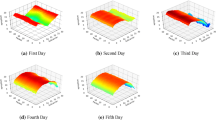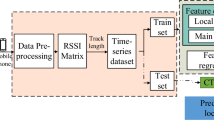Abstract
Device-free passive wireless indoor localization is attracting great interest in recent years due to the widespread deployment of Wi-Fi devices and the numerous location-based services requirements. In this paper, we propose DFPhaseFL, the first device-free fingerprinting indoor localization system that purely uses CSI phase information. It utilizes the CSI phase information extracted from simply a single link to estimate the location of the target, neither requiring the target to wear any electronic equipment nor deploying a large number of access points and monitor devices. In DFPhaseFL, the raw CSI phases are extracted from the CSI measurements through the three antennas of the Intel WiFi Link 5300 wireless Network Interface Card (IWL 5300 NIC) firstly. Then, linear transformation and noise filtering are applied to acquire the calibrated CSI phases. Through experimental observations, we find that the calibrated CSI phase owns an unpredictable characteristic over time. Thus, it cannot be directly applied as a fingerprint. To this end, a transfer deep supervised neural network method combining deep neural network and transfer learning is proposed to obtain feature representations with both transferability and discriminability as fingerprints. Then, the DFPhaseFL system uses the SVM algorithm to obtain the estimation of the target location online. Experiment results demonstrate that the DFPhaseFL owns a better estimation precision compared with the other state of art, and maintain a stable localization accuracy for a long time without reacquiring the fingerprint database.








Similar content being viewed by others
References
Zhou Z, Wu C, Yang Z, Liu Y (2015) Sensorless sensing with WiFi. Tsinghua Sci Technol 20(1):1–6
Savazzi S, Sigg S, Nicoli M, Rampa V, Kianoush S, Spagnolini U (2016) Device-free radio vision for assisted living: leveraging wireless channel quality information for human sensing. IEEE Signal Proc Mag 33(2):45–58
Youssef M, Mah M, Agrawala A (2007) Challenges: device-free passive localization for wireless environments. In: Proceedings of the 13th annual ACM international conference on Mobile computing and networking, ACM, pp 222–229.
Halperin D, Hu W, Sheth A, Wetherall D (2011) Tool release: Gathering 802.11 n traces with channel state information. ACM SIGCOMM Comput Commun 41(1):53
Abdel-Nasser H, Samir R, Sabek I, Youssef M (2013) MonoPHY: mono-stream-based device-free WLAN localization via physical layer information. In: Proceeding of the IEEE wireless communications and networking conference (WCNC), IEEE, pp 4546–4551
Wang J, Jiang H, Xiong J, Jamieson K, Chen X, Fang D, Wang C (2018) Low human-effort, device-free localization with fine-grained subcarrier information. IEEE Trans Mobile Comput 17:2550–2563
Li X, Li S, Zhang D, Xiong J, Wang Y, Mei H (2016) Dynamic-MUSIC: accurate device-free indoor localization. In: Proceedings of the 2016 ACM international joint conference on pervasive and ubiquitous computing, ACM, pp 196–207
Qian K, Wu C, Yang Z, Yang C, Liu Y (2016) Decimeter level passive tracking with WiFi. In: Proceedings of the 3rd workshop on hot topics in wireless, ACM, pp 44–48
Sabek I, Youssef M (2013) MonoStream: a minimal-hardware high accuracy device-free WLAN localization system. arXiv preprint. arXiv:1308.0768
Xiao J, Wu K, Yi Y, Wang L, Ni LM (2013) Pilot: passive device-free indoor localization using channel state information. In: Proceeding of the IEEE 33rd international conference on distributed computing systems, IEEE, pp 236–245
Zhou R, Lu X, Zhao P, Chen J (2017) Device-free presence detection and localization with SVM and CSI fingerprinting. IEEE Sens J 17(23):7990–7999
Zhou R, Hao M, Lu X, Tang M, Fu Y (2018) Device-free localization based on CSI fingerprints and deep neural networks. In: Proceeding of the 15th annual IEEE international conference on sensing, communication, and networking (SECON), IEEE, pp 1–9
Shi S, Sigg S, Chen L, Ji Y (2018) Accurate location tracking from CSI-based passive device-free probabilistic fingerprinting. IEEE T Veh Technol 67(6):5217–5230
Gong L, Yang W, Man D, Dong G, Yu M, Lv J (2015) WiFi-based real-time calibration-free passive human motion detection. Sensors 15(12):32213–32229
Vasisht D, Kumar S, Katabi D (2016) Decimeter-level localization with a single WiFi access point. In: Proceeding of the 13th USENIX symposium on networked systems design and implementation (NSDI), USENIX, pp 165–178
Kotaru M, Joshi K, Bharadia D, Katti S (2015) Spotfi: decimeter level localization using WiFi. In: Proceedings of the 2015 ACM conference on special interest group on data communication (SIGCOMM), ACM, pp 269–282
Xiong J, Sundaresan K, Jamieson K (2015) ToneTrack: leveraging frequency-agile radios for time-based indoor wireless localization. In: Proceedings of the 21st annual international conference on mobile computing and networking (MobiCom), ACM, pp 537–549
Gjengset J, Xiong J, McPhillips G, Jamieson K (2014) Phaser: enabling phased array signal processing on commodity WiFi access points. In: Proceedings of the 20st annual international conference on mobile computing and networking (MobiCom), pp 153–164
Sen S, Lee J, Kim K-H, Congdon P (2013) Avoiding multipath to revive inbuilding WiFi localization. In: Proceeding of the 11th annual international conference on Mobile systems, applications, and services (MobiSys), ACM, pp 249–262
Xiong J, Jamieson K (2013) ArrayTrack: a fine-grained indoor location system. In: Proceeding of the 10th USENIX symposium on networked systems design and implementation (NSDI)
Wang X, Gao L, Mao S (2016) CSI phase fingerprinting for indoor localization with a deep learning approach. IEEE Internet Things J 3(6):1113–1123
Gao Q, Wang J, Ma X, Feng X, Wang H (2017) CSI-based device-free wireless localization and activity recognition using radio image features. IEEE T Veh Technol 66(11):10346–10356
Si S, Tao D, Geng B (2010) Bregman divergence-based regularization for transfer subspace learning. IEEE T Knowl Data En 22(7):929–942
Banerjee S, Merugu IS, Dhillon J (2005) Ghosh, clustering with bregman divergences. J Mach Learn Res 6(4):1705–1749
Gong B, Shi Y, Sha F, Grauman K (2012) Geodesic flow kernel for unsupervised domain adaptation. In: 2012 IEEE conference on computer vision and pattern recognition, IEEE, pp 2066–2073
Pan SJ, Tsang IW, Kwok JT, Yang Q (2011) Domain adaptation via transfer component analysis. IEEE Trans Neural Netw 22(2):199–210
Borgwardt KM, Gretton A, Rasch MJ, Kriegel HP, Schölkopf B, Smola AJ (2006) Integrating structured biological data by kernel maximum mean discrepancy. Bioinformatics 22(14):e49–e57
Long M, Wang J, Ding G, Sun J, Yu PS (2013) Transfer feature learning with joint distribution adaptation. In: 2013 IEEE international conference on computer vision, IEEE, pp 2200–2207
Rao X, Li Z (2019) MSDFL: a robust minimal hardware low-cost device-free WLAN localization system. Neural Comput Appl 31(12):9261–9278
Hu J, Lu J, Tan Y (2015) Deep transfer metric learning. In: Proceedings of the IEEE conference on computer vision and pattern recognition (CVPR), IEEE, pp 325–333
Suykens JA, Vandewalle J (1999) Least squares support vector machine classifiers. Neural Process Lett 9(3):293–300
Platt J (1998) Sequential minimal optimization: a fast algorithm for training support vector machines. In: Technical report MSR-TR-98-14, Microsoft Research
Chang CC, Lin CJ (2011) LIBSVM: A library for support vector machines. ACM Trans Intell Syst Technol (TIST) 2(3):27
Balas VE, Roy SS, Sharma D, Samui P (2019) Handbook of deep learning applications, vol 136. Springer, New York
Acknowledgements
This work was supported by the National Natural Science Foundation of China (NSFC) under Grant Nos. 61673310 and 61703324.
Author information
Authors and Affiliations
Corresponding author
Ethics declarations
Conflict of Interest
The authors declare that they have no conflict of interest.
Additional information
Publisher's Note
Springer Nature remains neutral with regard to jurisdictional claims in published maps and institutional affiliations.
Rights and permissions
About this article
Cite this article
Rao, X., Li, Z., Yang, Y. et al. DFPhaseFL: a robust device-free passive fingerprinting wireless localization system using CSI phase information. Neural Comput & Applic 32, 14909–14927 (2020). https://doi.org/10.1007/s00521-020-04847-1
Received:
Accepted:
Published:
Issue Date:
DOI: https://doi.org/10.1007/s00521-020-04847-1




